Idols at Siddhachalam
(As published in Siddhachalam Pratishtha Mahotsav Souvenir, August 2-11, 1991)
Siddhachalam is the first Jain Tirth outside of India. This 108 acre premises is located near the Pocono Mountain range in New Jersey. The huge temple of Siddhachalam is a wonderful combination of tradition followed by different Jain sects such as Digambar, Shwetambar, Sthanakwasi, Terapanthi, etc.
The temple has at its main vedica the first Tirthankar Bhagwan Adinath as Mulnayak. Also, there is idols of Bhagwan Mahavir, Prabhu Parshvanath, Chandraprabhu and Bhagwan Shantinath.
Nine other Gods and goddesses who have been placed here are Bhagwan Bahubali, Manibhadra, Parshvayaksha, Virghantakaran, Shri Nakoda Bhairavji, Chakreshwari Devi, Padmavati, Sarasvati and Shri Laxmi Devi.
Here is a brief description of these idols:
Mulnayak Bhagwan Adinath Ji
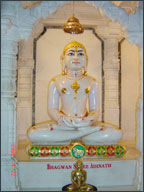 Bhagwan Adinath Ji is considered as the Adipurush, the first Tirthankara and first ruling King. According to Jain tradition, Adinath lived hundreds of thousands of years ago. Although historians have been sceptical of this claim, evidence found at the archeological sites at Mohanjodaro and Harrappa of the Indus valley civilization proves that he predated this 5000 years old civilization. Bhagwan Adinath was born into the royal family of Ayodhya as the son of King Nabhiraja and Queen Maru Devi. He was married to two wives Sumagla and Sunanda. Sumangla gave birth to Bharat, who later became a Chakravarti King. Sunanda gave birth to a child who came to be known as Bahubali.
Bhagwan Adinath Ji is considered as the Adipurush, the first Tirthankara and first ruling King. According to Jain tradition, Adinath lived hundreds of thousands of years ago. Although historians have been sceptical of this claim, evidence found at the archeological sites at Mohanjodaro and Harrappa of the Indus valley civilization proves that he predated this 5000 years old civilization. Bhagwan Adinath was born into the royal family of Ayodhya as the son of King Nabhiraja and Queen Maru Devi. He was married to two wives Sumagla and Sunanda. Sumangla gave birth to Bharat, who later became a Chakravarti King. Sunanda gave birth to a child who came to be known as Bahubali.
It is believed that Adinath had one hundred sons and two daughters named Brahmi and Sundari. Jain tradition holds that all civilization developed from the teachings of Adinath.
He was the first king to establish the institution of marriage, Agriculture, the Arts, Weaponry (Swordmanship, archery, etc.). After organizing and instructing the society in various disciplines, he ruled for thousands of years.( The system to measure time during that period is still unknown).
After this, he divided his kingdom among his sons and departed to take up an ascetic way of life. When Adinath renounced his kingdom, thousands of people followed him into the ascetic life.
Whenever they went for alms, people offered them gold. Thus, many of his followers could not tolerate the starvation and began to ask for food, then left to form their own groups. This was the beginning of many sects.(According to Jain faith, Tirthankaras remained silent until they achieved perfection).
Adinath also went without food for an entire year. Then he went to his grandsons Shreyan’s Kingdom (Hastinapur). His grandson offered him sugarcane juice, which he accepted. Hastinapur is still considered a holy place, and to this day Jains make Pilgrimages to this site to break ritual fasts (with sugarcane juice).
After becoming enlightened (Perfect), He broke his silence and preached for many years, how to get rid of the cycle of birth and death and achieve eternal bliss.
Bhagwan Adinath achieved Nirvana on the mountain of Kailash in the Himalayas when he was in complete Samadhi. The symbol of Adinath is a Bull (Rishabh). He became popular by this symbol and is now also known as Rishabh Deva.
Bhagwan Parsvanath
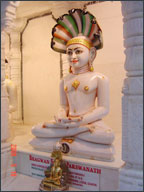 According to Jain belief, Bhagwan Parsvanath is the twenty-third Tirthankar. He was born 250 years prior to Lord Mahavir. He was son of King Ashvasen and Queen Vamadevi of Varanasi. It is said that he was named as Parsvanath after an incident his mother experienced when the child was still in her womb.The mother found that a snake was lying next to her. Parsva means ‘by the side of’ — hence the name Parsvanath.
According to Jain belief, Bhagwan Parsvanath is the twenty-third Tirthankar. He was born 250 years prior to Lord Mahavir. He was son of King Ashvasen and Queen Vamadevi of Varanasi. It is said that he was named as Parsvanath after an incident his mother experienced when the child was still in her womb.The mother found that a snake was lying next to her. Parsva means ‘by the side of’ — hence the name Parsvanath.
Young Prince Parsva grew up as a great scholar and warrior. He was married to the daughter of Raja Prasenjit, Kumari Prabhavati. Whenever his Kingdom was attacked by another King Yavanraj, Parsva went ahead to defeat the enemy after taking the permission of his father to fight.Yavanraj was defeated not by armed fight but during intellectual discussion.
Impressed by the scholarly discussion of Parsvanath, Yavan became his follower. Parsva forgave him and inspired him to adopt non-violence.
Once Parsva went to witness ‘Panchagni Tapa’ being performed by Kamath, he discovered a cobra couple in the firewood and saved their life. With the help of ‘Namokar Mantra’, the cobras were sent to heaven by Parsvanath.
His action had angered Kamath who thought Parsva had disturbed his holy life. Kamath who had become Meghmali created many obstacles in the meditation process of Parsvanath. He flooded the place where Parsvanath was deeply engrossed in austerity. Then the Cobra Couple who were now Dharmendra and Padmavati raised a Lotus seat below meditating Parsva and thus saved him from drowning. For the noble work done by Dharmendra and Padmavati at Sammed Shikhar (Bihar) Jain followers worship them as a God and Goddess.
According to historical facts, Bhagwan Parsvanath got Nirvana after attaining Kaivalya. He was accompanied by 23 Munis on his way to Nirvana in 720 B.C.
His symbol is snake and had a life of 100 years. He is worshipped by all the sects of Jainism with equal faith and respect.
Mahavira
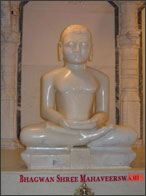 The last Tirthankar (24th) Mahavira was a historical personality who was born in 599 B.C. at Kshatriya Kund in the democratic republic of Vaishali(Bihar). He was the son of King Siddhartha and Queen Trishla Devi.
The last Tirthankar (24th) Mahavira was a historical personality who was born in 599 B.C. at Kshatriya Kund in the democratic republic of Vaishali(Bihar). He was the son of King Siddhartha and Queen Trishla Devi.
His original name was Vardhman. Ever since his childhood, he was soft and kindhearted. He was very upset by the ritual sacrifice of animals, and vowed to fight for the rights of animals. He also wished to fight for the upliftment of women and untouchables.
He left his kingdom at the age of 30 to begin an ascetic life. He entered the forest to communicate with every living being, including plants, trees, and animals. He practiced meditation, austerity and samadhi for 12 years to get enlightenment. By self-purification and severe spiritual practices, finally, at the age of 42, he attained Kaivalya (perfection).
For the next 30 years he spread the message of non-violence, truth, non-stealing right conduct and non-possession.
He advocated against the barriers of caste creed and faith. He also talked to protect all living creatures.
Lord Mahavira gave us several analytical theories of Karma, multiplicity of truth, Syadvad, etc. All these theories help the human being in reaching highest level of consciousness and happiness and peace in society His preachings of Right Knowing, Right Vision and Right Conduct are considered three Jewels of Jain philosophy which means to achieve the ultimate goal in life.
The symbol of Lord Mahavira is Lion indicating a fearIess life he lived. He is the most important of all the Tirthankaras, as most of Jain scriptures are spoken by him.
Lord Mahavira advocated Ahimsa which was further carried by great men of history including Mahatma Gandhi and Martin Luther King. He attained ‘Nirvana’ at the age of 72 at Pavapuri in Bihar.
Bhagwan Shantinath Ji
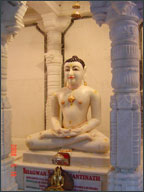 The sixteenth Tirthankar of the Jain religion, Shantinath was born to the King Vishavsen and Queen Achiradevi ofHastinapur. It is said that as soon as he entered the womb of his mother, diseases were cured, peace and happiness prevailed throughout the area. Because of this, he came to be called Santinath (peacemaker).
The sixteenth Tirthankar of the Jain religion, Shantinath was born to the King Vishavsen and Queen Achiradevi ofHastinapur. It is said that as soon as he entered the womb of his mother, diseases were cured, peace and happiness prevailed throughout the area. Because of this, he came to be called Santinath (peacemaker).
When he was very young, he became an expert in the use of many weapons. These skills enabled him to become a king at a very young age. Eventually, he became known as Chakarvarti (King of Kings).
He enjoyed his kingdom and its riches for thousands of years. One day, however, he saw his own aging reflection in a mirror and realized that his body was not as young and beautiful as it used to be. Thus he came to know that all the riches and even man itself are not eternal. At that moment he was inspired to become an ascetic.
He became enlightened on the eleventh moonlit night of Paush (Feb-March). For many years, he went from city to city, spreading the message of peace, non-violence and harmony. Finally, he achieved Nirvana on the mountain of Sammed Shikhar (Bihar). His symbol is a deer (Mriga). He is considered a god to bestow peace and happiness.
Tirthankar Shri Chandra Prabhu
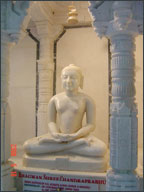 The eighth Tirthankar of Jainism is Chandra Prabhu. He was born to King Mahasen and Queen Sulakshana. When the Queen was bearing the child, she desired to swallow the nectar of the moon. Her wish was fulfilled and a son with moonlike complexion was born.That is how he was named Chandra Prabhu.
The eighth Tirthankar of Jainism is Chandra Prabhu. He was born to King Mahasen and Queen Sulakshana. When the Queen was bearing the child, she desired to swallow the nectar of the moon. Her wish was fulfilled and a son with moonlike complexion was born.That is how he was named Chandra Prabhu.
He got married to more than one princess. After ruling his kingdom for a long time, he got initiation (Diksha). Chandra Prabhu attained Kaivalya after meditating for many months. For many years he served the living beings and then went to ‘Sammed’ Mountain in Bihar. He was accompanied by one thousand munis. All of them meditated for one month before getting Nirvana.
Today, the temple of Chandra Prabhu at Tijara in Rajasthan is a famous center of pilgrimage for Jains.
Symbol of Chandra Prabhu is ‘halfmoon’. He brings smoothness and happiness to every living being. Large numbers of believers visit the tirth of Tijara every week.
DEVTA
Manidhari Dadaguru Jinchandra ji
About 800 years ago, there was a very influential Jain Acharya in Shwetambar Sect. His name was Acharya Manidhari Jinchandra Suri. He was born in Lodhrapur (Rajasthan) His Guru was Dada Jindutt Suri.
Jinchandra is known to have use his mantra for changing a moonless night into full moon night by sending a dish to sky. He preached to millions of people about nonviolence and vegetarianism. He did many miracles and inspired people to adopt Jain principles.
He had desired that after his death, his dead body may not be kept on ground halfway through the funeral journey. But then no body, not even elephants could lift it to continue the procession. Hence there was no option than to build his Samadhi at that place only.
He had declared that a jewel, ‘Mani’ will come out of his head after death. He advised his followers to keep the jewel in a cup of milk. This forecast came true. Thus he is called ‘Manidhari Dada Guru’ meaning the jewel holder.
His Samadhi is at MehrauIi near Delhi. The place is now a pilgrimage Center. It is visited by thousands of people. Nowadays, it is as famous as Dadawadi.
Manibhadraji
Manibhadra was a great king who was devoted to Jain religion and preachings. He had enormous wealth and was also very fond of 36 musical instruments. Later on Acharya Hem Vimal Suri declared him as Kshetrapal because of his tremendous devotion.
The carrier of Manibhadra Dev is Airavat, the white elephant. His face on statues is sometimes depicted as an elephant, and sometimes as Varah. His idols are shown with four arms, and sometimes we also see him with six arms.
In Magarvada (Gujarat), there is an idol of Manibhadra where large numbers of devotees go to get their desires fulfilled. He is known to create miracles.
It is believed that one gets wealth and protection from evil spirits by worshipping Manibhadraji.
He is highly respected among the Tapagachha sect of Sawetambar Jains.
He is specially worshipped on ‘Ashtami’ Chaudas and Divali for getting name and fame in the society. He likes the sound of temple bells. Manibhadraji is the protecting god of Siddhachalam Tirth.
Ghantakarna Mahavir
Ghantakarna Mahavir is highly respected by Swetamber Jain. He is placed at 30th position among 52 heroes. He is a miracle god of Riddhi Siddhi and a troubleshooter His idols have bell like ears that is why he is called Ghantakarna. Temple of Ghantakarna at Mahuri (Gujarat) is very much known for producing miracles – wishes of worshippers are fulfilled here
Parsva Yaksha
Lord Parsva Yaksha is divine guardian associated with the 23rd Tirthankar Parsvanath. His complexion is dark, he has elephant like face and his head is sheltered by the hood of cobra. He has four arms. His carrier is tortoise. He holds special fruit known as Bujpurak and snake to his right side. In his left hands he holds snake and Mongoose. He is considered very influential and also compared with Ganesh, who is a Hindu God.
Nakoda Bhairav Ji
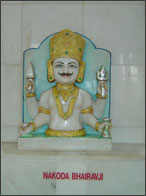 Lord Nakoda Bhairav Ji is divine guardian associated with the ancient Jain pilgrimage center of Sammed Shikhar. He is worshipped before the beginning of Journey to avoid obstacles. Nakoda Bhairav Ji protects us from evil powers, ghosts, spirits, etc. He blesses the issueless with sons and daughters and relieves us from the worldly ties.
Lord Nakoda Bhairav Ji is divine guardian associated with the ancient Jain pilgrimage center of Sammed Shikhar. He is worshipped before the beginning of Journey to avoid obstacles. Nakoda Bhairav Ji protects us from evil powers, ghosts, spirits, etc. He blesses the issueless with sons and daughters and relieves us from the worldly ties.
Bhagvan Bahubali
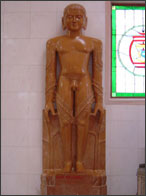 Bahubali was the younger son of the first Tirthankar Rishabhdev. He later became king of Podanpur. His elder brother Bharat was bent upon attacking Bahubali’s Kingdom. Their ministers suggested and agreed for three wars to be fought by their kings. All these wars ‘Drishti Yudha’, ‘Jal Yudha’ and ‘Wrestling’ were won by Bahubali against his elder brother.
Bahubali was the younger son of the first Tirthankar Rishabhdev. He later became king of Podanpur. His elder brother Bharat was bent upon attacking Bahubali’s Kingdom. Their ministers suggested and agreed for three wars to be fought by their kings. All these wars ‘Drishti Yudha’, ‘Jal Yudha’ and ‘Wrestling’ were won by Bahubali against his elder brother.
Bahubali was very much hurt by the behaviour of his elder brother. He decided to surrender his kingdom to Bharat and left for the path of meditation. He did not want to bow before his other brothers who had already accepted acestic life.
This ego of Bahubali deterred him from visiting his father’s court. Hence he went on meditating but could not attain the Keval Jnana, the supreme knowledge.
Bahubali was so much involved in his Samadhi, that his body got covered by creepers, ants and dust. Finally he was woken up from his ego when his sisters called him to release the false pride he was suffering from. Bahubali got enlightened and decided to see his father. Thanks to his sisters Brahmi and Sundari, Bahubali was now a changed person with knowledge and better understanding. He was welcomed in his father’s court. The world got the benefit of his wisdom.
Bahubali is symbol of leaming. His tall one rock statue is standing 57 feet high in Karnataka since thousand of years conveying the world the message of knowledge and austerity.
DEVI
Ambika Devi
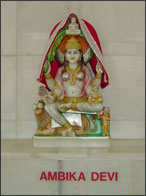 Ambika is the divine guardian associated with the twenty-second tirthankar Lord Nemimath. Her other names are Amba, Ambini, Kushmandi and Kodandi. Her carrier is a lion. She is of golden complexion and has four arms. By worshipping her, one gets all desires fulfilled. All obstacles are removed and Riddhi-Siddhi is achieved.
Ambika is the divine guardian associated with the twenty-second tirthankar Lord Nemimath. Her other names are Amba, Ambini, Kushmandi and Kodandi. Her carrier is a lion. She is of golden complexion and has four arms. By worshipping her, one gets all desires fulfilled. All obstacles are removed and Riddhi-Siddhi is achieved.
She holds special fruits (BeejPurak) and mercury in right hands and Ankush and son in her left hands.
She is considered miraculous and always decorated with gems and jewelry. Folklore is that she was thrown out of her house by her husband and mother-in-law because she had given alms to a great monk. After that she started living in the bushes outside Ambikanagar. After a few days some monks visited her house.
Because of the effect of the visit of great monks, Ambika’s utensils turned into gold. This incident surprised the villagers who became her devotees. Ambika later on was born as a Riddhi Siddhi Devi. Ambika even today commands tremendous respect
Chakreshwari Devi
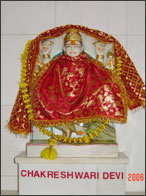 Chakreshwari Devi is divine guardian associated with the first Tirthankar Rishabhdev. Her carrier is ‘Garud’. We find a number of different types of her idols and statues. Some of them are of four hands, eight and twelve hands. She holds chakra in one hand, and garland, Vajra, sword, bow and Vard Mudra (sign of fearlessness). She is also Lakshmi, wife of Vishnu according to Hindu tradition. She is the goddess of spiritual upliftment
Chakreshwari Devi is divine guardian associated with the first Tirthankar Rishabhdev. Her carrier is ‘Garud’. We find a number of different types of her idols and statues. Some of them are of four hands, eight and twelve hands. She holds chakra in one hand, and garland, Vajra, sword, bow and Vard Mudra (sign of fearlessness). She is also Lakshmi, wife of Vishnu according to Hindu tradition. She is the goddess of spiritual upliftment
Padmavati Devi
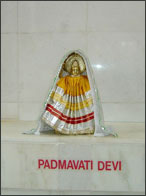 Goddess Padmavati is divine guardian associated with Parsvanath. She is most respected Yakshini among all of the gods and goddesses. She is said to have protected Lord Parsvanath from the curses of Kamath and produced Lotus for him to sit over the surface of water. She holds Lotus, tiding rope in her right hand and fruit, Ankush in her left hands. Her carrier is Snake of Kurut Variety. She is also worshipped by Hindus, especially at the temple of Tirupati.
Goddess Padmavati is divine guardian associated with Parsvanath. She is most respected Yakshini among all of the gods and goddesses. She is said to have protected Lord Parsvanath from the curses of Kamath and produced Lotus for him to sit over the surface of water. She holds Lotus, tiding rope in her right hand and fruit, Ankush in her left hands. Her carrier is Snake of Kurut Variety. She is also worshipped by Hindus, especially at the temple of Tirupati.
Saraswati Devi
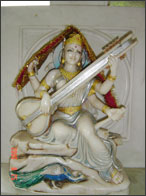 She is the goddess of learning. Her carrier is Swan. She is full of affection. According to Jain pbilosophy Saraswati is worshipped for education and knowledge. Always dressed in white, holding Lotus, book, Veena and garland in her four hands, the goddess is believed to bless the worshipper with good thinking, good behavior and knowledge.
She is the goddess of learning. Her carrier is Swan. She is full of affection. According to Jain pbilosophy Saraswati is worshipped for education and knowledge. Always dressed in white, holding Lotus, book, Veena and garland in her four hands, the goddess is believed to bless the worshipper with good thinking, good behavior and knowledge.
Lakshmi Devi
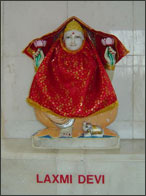 Lakshmi is the goddess of beauty power and prosperity. Acharya Nemichandra has also described her as Padma, Rama, Shri, Kamala and Indira. She is worshipped for happiness and wealth, especially on Diwali. She is depicted with four hands, holding lotus in the upper two hands. One lower hand holds KaIash (Pitcher) and the other one is raised for blessings. She has been described as the fourth dream of Mahavira’s mother.
Lakshmi is the goddess of beauty power and prosperity. Acharya Nemichandra has also described her as Padma, Rama, Shri, Kamala and Indira. She is worshipped for happiness and wealth, especially on Diwali. She is depicted with four hands, holding lotus in the upper two hands. One lower hand holds KaIash (Pitcher) and the other one is raised for blessings. She has been described as the fourth dream of Mahavira’s mother.


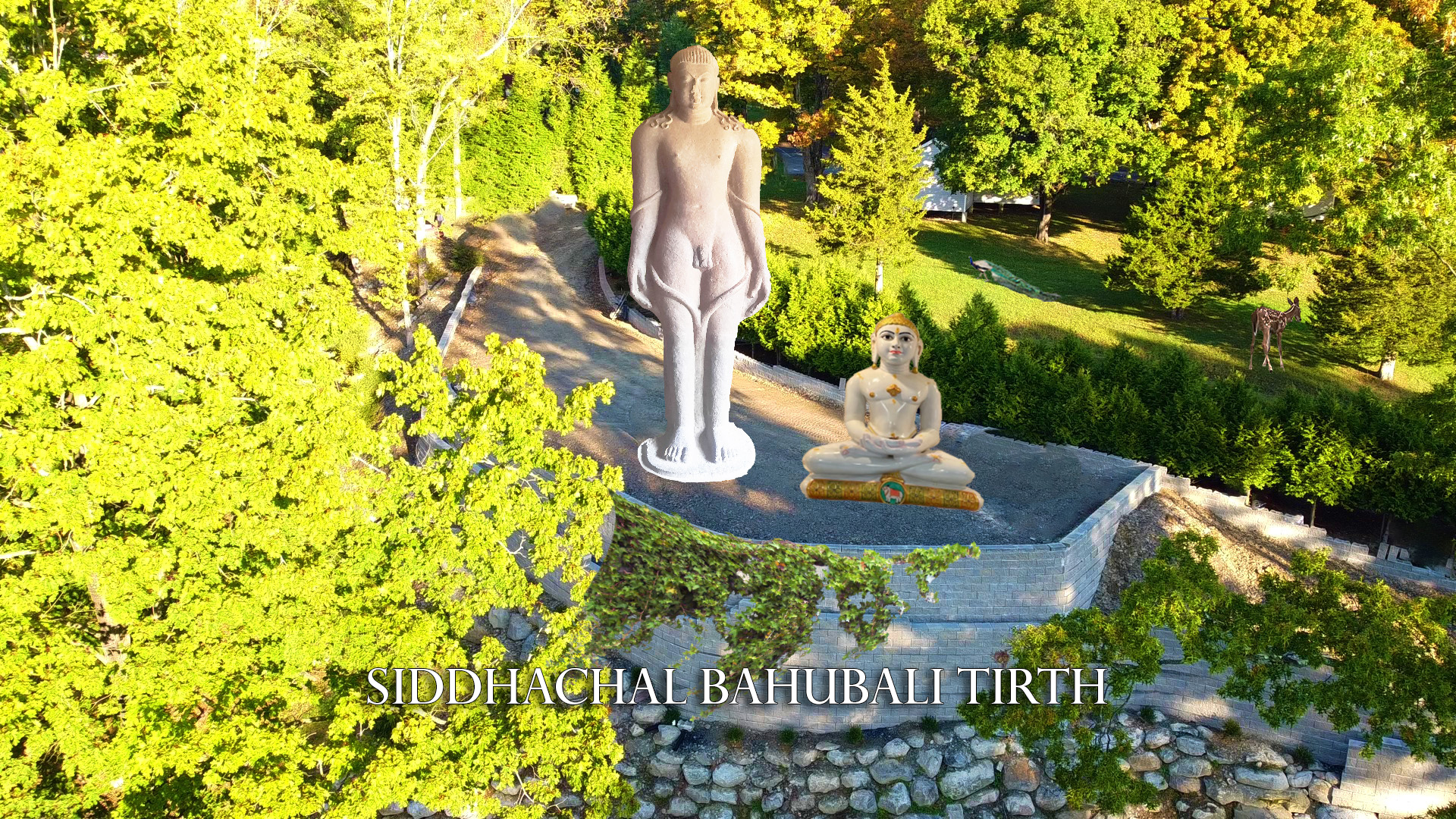 Keshi said to Gautam: “Whom do you call foes?” Hearing these words of Keshi, Gautam replied: “O sage! The first foe is one’s unconquered soul. Add to this the four passions of anger, conceit, deceit and greed, and the five senses of touch, taste, smell, sight and hearing. Vanquishing all these ten, I move about righteously.” Kumar-shraman Keshi said: “Gautam, you are endowed with excellent wisdom. You have removed my doubt…” Uttaradhyayana Sutra, 23:3- 39. The conversation between Sharman Keshi, follower of Bhagwaan Parsvanath, and Gautam Swami, the ganadhara of Bhagwaan Mahavira.
Keshi said to Gautam: “Whom do you call foes?” Hearing these words of Keshi, Gautam replied: “O sage! The first foe is one’s unconquered soul. Add to this the four passions of anger, conceit, deceit and greed, and the five senses of touch, taste, smell, sight and hearing. Vanquishing all these ten, I move about righteously.” Kumar-shraman Keshi said: “Gautam, you are endowed with excellent wisdom. You have removed my doubt…” Uttaradhyayana Sutra, 23:3- 39. The conversation between Sharman Keshi, follower of Bhagwaan Parsvanath, and Gautam Swami, the ganadhara of Bhagwaan Mahavira.